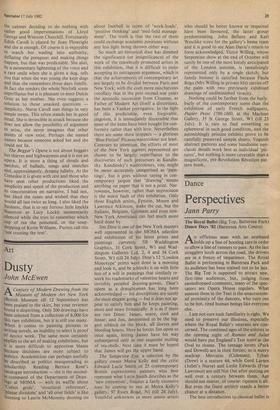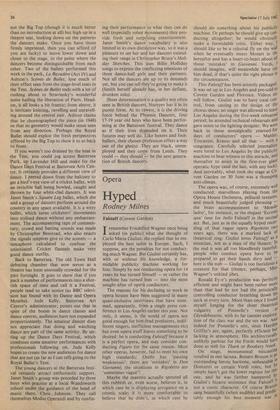Dance
Perspectives
Jann Parry
An officious man with an armband holds up a line of hooting cars in order to allow a line of runners to pass. As the last stragglers lurch across the road, the drivers are in a frenzy of impatience. The Royal Ballet is performing in Battersea Park and its audience'has been trained not to be late. The Big Top is supposed to attract new, first-time audiences, but, judging from eavesdropped comments, many of the spec- tators are Opera House regulars. What amazes them in the Tent is the unaccustom- ed proximity of the dancers, who turn out to be hot, tired human beings like everyone else.
I am not sure such familiarity is right. We need to preserve our illusions, especially where the Royal Ballet's veterans are con- cerned. The combined ages of the soloists in the opening night of Romeo and Juliet would have put England's Test score at the Oval to shame. The teenage lovers (Park and Dowell) are in their forties; so is merry madcap Mercutio (Coleman); Tybalt (Drew) is a mature 44; while Gerd Larsen (Juliet's Nurse) and Leslie Edwards (Friar Lawrence) are still Not Out after putting on well over a century between them. Age should not matter, of course: ripeness is all. But even the finest artistry stands a better chance at a distance.
The best introduction to classical ballet is
not the Big Top (though it is much better than no introduction at all) but high up in a theatre seat, looking down on the patterns the dancers make. Once you have those firmly imprinted, then you can afford (if you are lucky) to move lower down and closer to the stage, to the point where the dancers become distinguishable from each other. Two of the ballets performed this week in the park, La Bayadere (Act IV) and Ashton's Scenes de Ballet, lose much of their effect seen from the stage-level seats in the Tent. Scenes de Ballet ends with a lot of rushing about to Stravinsky's wonderful noise hailing the liberation of Paris. Head- on, it all looks a bit frantic; from above, it is intricate knitting, ravelling and unravell- ing around the central pair. Ashton claims that he choreographed the piece (in 1948) so that its geometry would make sense seen from any direction. Perhaps the Royal Ballet should exploit the fresh perspectives offered by the Big Top to show it to us back to front.
If you weren't too drained by the heat in the Tent, you could jog across Battersea Park, up Lavender Hill and make for the Dance Days Festival at Battersea Arts Cen- tre. It certainly provides a different view of dance. I peered down from the balcony to get a bird's-eye view of a cricket ballet, with an invisible ball being bowled, caught and thrown by four white-clad dancers. It was Janet Smith's Square Leg ballet, which she and a group of dancers perform around the country in any space available. It is a witty ballet, which turns cricketers' movements into stylised dance without any embarrass- ment. The accompanying tape of commen- tary, crowd and batting sounds was made by Christopher Benstead, who also enacts the signals umpires give to the scorers — a semaphore calculated to confuse the uninitiated. Cricket flannels make very good dance outfits.
Back to Battersea. The old Town Hall debating chamber that now serves as a theatre has been unusually crowded for the past fortnight. It goes to show that if you pack a number of performances into a shor- tish space of time and call it a Festival, people tend to take notice (as BBC televi- sion has found with its Dance and Opera Months). Jude Kelly, Battersea Art Centre's administrator, points out that in spite of the boom in dance classes and dance centres, audiences have not expanded proportionately. The amateur dancer does not appreciate that doing and watching dance are part of the same activity. By set- ting up the Dance Days Festival, which combines some amateur performances with professionals following on, Jude Kelly hopes to create the new audiences for dance that are not (as far as I can tell) going to the Royal Ballet's Tent.
The young dancers at the Battersea festi- val certainly attract enthusiastic support. Janet Smith's group was preceded by three boys who practise at a local Wandsworth school under the guidance of the head of music there, Chris Johnson. They call themselves Modus Operandi and by con fin- ing their performance to what they can do well (especially robot movements) they pro- vide fresh and surprising entertainment. Janet Smith's dance vocabulary is also limited in its own distinctive way, so it was a pleasure to see her and her dancers extend- ing their range in Christopher Bruce's Holi- day Sketches. This uses Billie Holliday songs to express the conflicting emotions of three dance-hall girls and their partners. Not all the dancers are up to its demands yet, but you can tell they're going to make it (Smith herself already has, in her defiant, drunken solo).
Sheer determination is a quality not often seen in British dancers. Nureyev has it in its purest form. At its rawest, it is the driving force behind the Phoenix Dancers, four 17-19 year old boys who have been perfor- ming at the Battersea festival. They dance as if their lives depended on it. Their futures may well do. Like boxers and foot- ballers, their chosen profession offers a way out of the ghetto. They are black, unem- ployed and they come from Leeds. They could — they should — be the next genera- tion of British dancers.



































 Previous page
Previous page